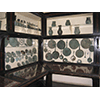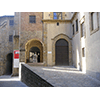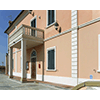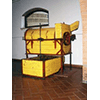Val di Cecina

The Val di Cecina constituted the route that from the sea led to one of the most powerful Etruscan metropolises: Volterra. Since antiquity, the economy of the valley was tied to the extraction of two precious materials: salt and alabaster. It was precisely this calcareous stone that Volterra and the production centres gravitating around it used, from the III century B.C., to make the little cinerary urns widely exported throughout northern Etruria.
The history of milling alabaster as of the Etruscan epoch can be traced back by visiting the collections of the Museo Etrusco Guarnacci of Volterra, which in addition to an important collection of urns, also offers the reconstruction of an ancient workshop.

The Museo Guarnacci, one of the oldest Italian archaeological museums, was founded in the middle of the 18th century thanks to the donation of Mario Guarnacci, a priest from Volterra, to all of the inhabitants of the city. Over the course of more than two centuries the collection has been continuously enriched by new objects found in Volterra and its territory.
A substantial part of the display is dedicated to cinerary urns in alabaster and tufo (with a few made of terracotta) produced at Volterra from the 3rd to the 1st century B.C. Visitors looking for scientific evidence will be interested in the laboratory set up on the museum's second floor. It is, in fact, a replica of the interior of an ancient workshop for the production of funerary urns. The implements used for processing alabaster are those of the modern craftsmen, who continue to follow an age-old tradition using tools very similar to the ancient ones.
A group of bronze surgical instruments (scalpels, spatulas, forceps), probably dating from the time of Imperial Rome, is also of interest.
(Elena Fani)
The developments in mining and milling alabaster in later epochs are instead illustrated in the exhibition stations of the Ecomuseo dell’Alabastro throughout the territory, including the outstanding museum of Volterra.

The Ecomuseum of Alabaster purposes to study, preserve and valorise the characteristic alabaster activity of the area that embraces the Communes of Castellina Marittima, Santa Luce and Volterra. The museum station of Volterra proposes the alabaster manufacture and marketing itinerary from the Etruscans to the present day. One section is dedicated to techniques, and another to manufacture history.
(Graziano Magrini)
At the foot of the hill on which Etruscan-medieval Volterra stands, instead lies one of the most important veins of halite in Italy, whose exploitation for centuries guaranteed the city’s wealth. A token of its long history is still conserved on plaques walled onto the little building erected in the late 18th century in the locality of San Leopoldo alle Saline.
At the foot of the hill where the ancient Volterra stands lies some of the most extensive halite deposits in Italy. This precious material was subjected to systematic exploitation since the Etruscan epoch, though the first direct testimony dates to the Roman period. Around 980, it appears the Emperor Otto II turned to the master salters of Volterra to start exploiting the halite mines that had been recently discovered in Saxony. Throughout the Middle Ages, the economy of Val di Cecina and of Volterra itself was based on salt extraction. The rights of exploitation of the deposits were at length the object of harsh disputes between the Bishop-Count and the nascent Communal authority. After Florence conquered Volterra (1472), the salt mines were exploited by the Medici family, but it was only with the Lorraines that the extraction assumed an industrial character. Peter Leopold, in particular, stimulated the renewal of the complex. The Grand Duke himself, in 1733, provides one of the most vivid and faithful descriptions of the production structures: «The salterns or salt pans … consist of 5 potholes of salty water from which in 24 hours, hand-operated capstans extract 500 buckets of water, which via certain canals flows into a tank and from here, via other canals, into the 8 boilers where salt is made. These are grouped in the same warehouse and are made of lead; a fire continuously burns beneath them day and night, all year round except for Easter; every 3 hours, wooden rakes are used to pull the salt out of the boiler, and new water is added … Each boiler is staffed by three men … the fires consume 100 loads of wood per day and, around the salt pans, for a distance of 5 miles, extends a reserve of which all wood is destined to serve the salt pans. Every 3 months, the boilers are renewed with lead; a large stone mould is used for the boilers; the lead in pieces is placed on top, and then piles of firewood are heaped on and then set on fire; the lead melts and takes the shape of the boiler. As the salt is removed from the boilers and dried, it is immediately bagged and sent to the warehouses in Volterra». Following the annexation of the Grand Duchy to the Kingdom of Italy, the salterns became Royal property, and later passed under the administration of the State Monopolies (today Atisale). Still today, the commemorative plaques are visible on the little building constructed in Piazza della Salina between 1787 and 1790 by architect Filippo Grobert by order of Grand Duke Leopold II.
(Elena Fani)
Crossing the valley on state highway SR68/SS68, proceeding towards the sea, a brief detour onto SP13 leads to the medieval village of Castellina Marittima, location of a second museum station tied to the Ecomuseo dell’Alabastro.

At Castellina Marittima, in the former Palazzo Opera Pia, is the Central Museum Unit of the Ecomuseo dell'Alabastro (other museum units are located at Volterra and Santa Luce). The exhibition, designed to stimulate interest in visiting the territory, displays historical documents and instruments utilised in working alabaster. Alabaster deposits are found also at Riparbella, at Montecatini Val di Cecina and at Volterra.
(Graziano Magrini)
Proceeding then towards Cecina, on the Tyrrhenian coast, the itinerary comes to its natural conclusion with a visit to the Museo della Vita e del Lavoro, which illustrates the old trades of the people who inhabited this territory.

The Museum, founded in 1992, contains implements used by farmers in the territory of northern Maremma. In 2003 the new exhibition design was inaugurated on the premises of the eighteenth-century Villa Guerrazzi. The collection is organised by themes: working the earth (ploughs, wagons, mowing machines, threshing machines), grain (ventilators, sieves, forage choppers), wine (grating to separate stalks from grapes, whirlpool basin for grapes, sulphur sprayer, hoppers Some weaving implements are also included in the exhibition.
(Francesco Marchetti)
****************************
Texts by Elena Fani
English translation by Victor Beard
Last update 14/gen/2008



 = libraries and archives
= libraries and archives  = scientific research centers
= scientific research centers  = memorial places of scientists
= memorial places of scientists = public health places
= public health places = places of science and worship
= places of science and worship = places of technology
= places of technology  = museums and collections
= museums and collections  = villas and gardens of science
= villas and gardens of science

